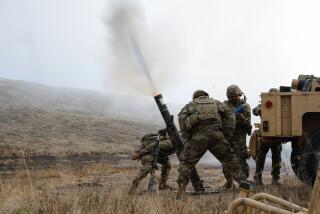Plan Would Raze Most of Navy Hospital When City Gets Land
A special Park and Recreation Board committee has voted to preserve seven of the 42 buildings of the soon-to-be-vacated Navy Hospital in Balboa Park, scrapping the others and a large parking lot to create open, grassy parkland.
Among the buildings that would be bulldozed on the 51-acre parcel is an 18-year-old, $1-million medical library that is the envy of many community groups hoping to stake a claim to part of the complex.
“I don’t think anyone is completely happy with it, but I guess we can all live with it,” committee chairwoman Ann Hix said of the compromise plan, reached Wednesday after a year of often-boisterous negotiations marked by a notable absence of common ground.
But Dan Marnell, vice president of the Pacific Southwest Railway Museum, labeled the proposal “pure folly.”
Marnell, whose group is one of many hoping to use the library after the city takes over the land in June, 1988, said the committee is composed “almost exclusively of open-land-use advocates and historic preservationists” who were incapable of “deep, insightful thought on the issue.”
Consisting of some of San Diego’s choicest available land, the parcel has been a source of conflict ever since the Navy decided six years ago to build a new hospital half a mile away in Florida Canyon. In exchange, the Navy gave the city part of the hilltop site. The committee met 17 times before reaching the final compromise.
After the panel completes its version by the end of the month, the proposal will go to the Park and Recreation Board and then to the City Council.
While panelists swiftly agreed that two-thirds of the parcel--containing 15 nondescript buildings and a parking lot--should be returned to grass, discord reigned over the 25 buildings on the upper 16-acre section, which commands a view of San Diego Bay and the downtown skyline.
“It basically came down to what people want out of a park,” said committee member Katherine Rosenberry. “When some people think of the park, they think of large green spaces where kids can play; when others think park, they think of museums and zoos and restaurants and other activities.”
While some committee members favored razing all the buildings on the site, others wished to retain the vast majority of the structures, which were thought to be of historical significance. Among the buildings to be saved are the main structure, the two flanking it and the hospital’s chapel, all of which were built before or during World War II, Hix said.
“We decided that we wanted to preserve at least one of the courtyards. Our objective was to maintain the essential feel of the hospital, without keeping all the buildings,” Hix said.
But the board was unanimous in its resolve to tear down the medical library, according to Rosenberry. “This is an extremely valuable piece of land, and the fact that a structure is still usable is not enough to justify retaining it--particularly a rather unattractive building,” she said.
The library, one of only two buildings at the hospital site that meet earthquake standards, has received several design awards. The buildings to remain standing under the plan must be renovated to meet earthquake standards for public use. The committee has yet to produce a cost estimate of the proposed changes, Hix said.
Hix and others conceded that, despite the long debate involved in reaching the compromise plan, it is likely to be only the first round in the battle over use of the hospital buildings.
“Because we weren’t asked to decide on the use of the buildings we decided to save, we were far less susceptible to that sort of pressure. It’s bound to get even more political from now on in,” Hix said.
Marnell said he is confident that the City Council will be “far more catholic in the perspectives it considers,” and that “chances are excellent” that the library can be saved for his or another group.
More to Read
Sign up for Essential California
The most important California stories and recommendations in your inbox every morning.
You may occasionally receive promotional content from the Los Angeles Times.









